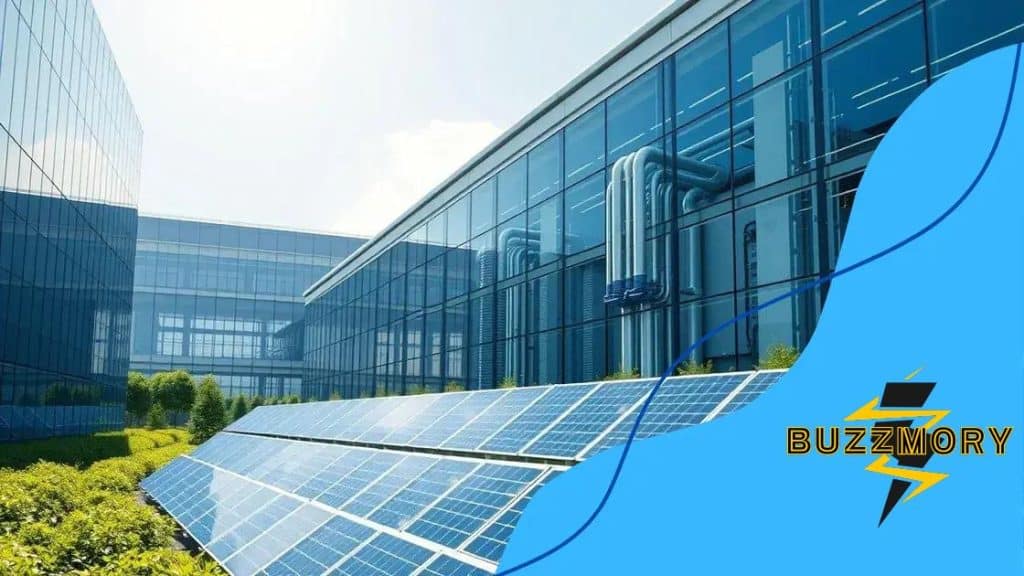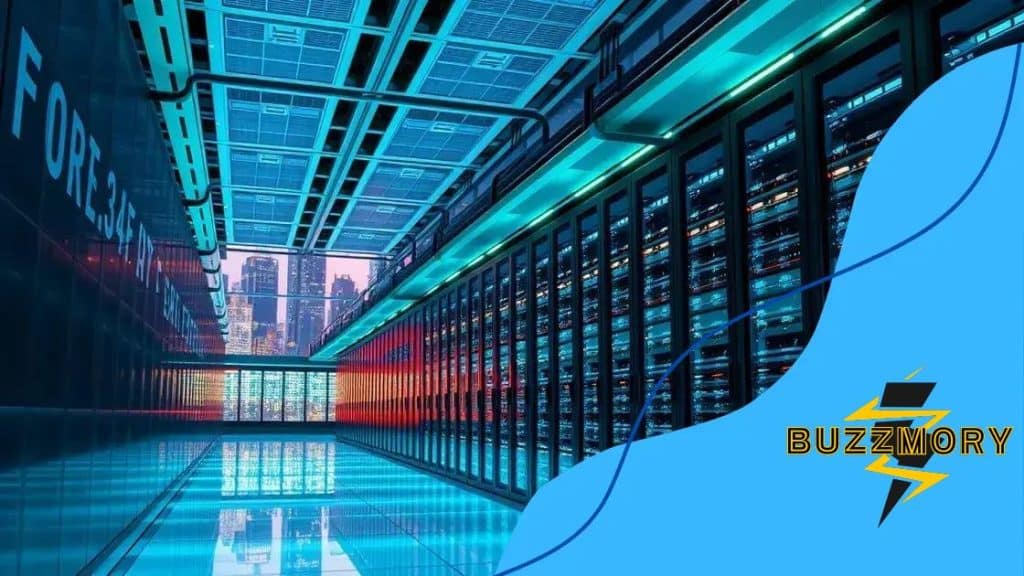AI data centers power demand strain: Challenges and solutions

AI data centers power demand strain are increasingly facing power demand strains, requiring innovative solutions like energy-efficient technologies, renewable energy integration, and smart energy management systems to ensure sustainability and operational efficiency.
AI data centers power demand strain is an increasingly pressing issue as the reliance on artificial intelligence grows.
It raises important questions about efficiency, sustainability, and the future of technology. Let’s explore how these factors intertwine and what can be done.
Understanding AI data centers
Understanding AI data centers is essential in today’s technology-driven world.
These centers are the backbone of modern artificial intelligence applications, hosting vast amounts of data and performing complex calculations.
What are AI data centers?
AI data centers are facilities that provide the necessary infrastructure for artificial intelligence operations. They consist of powerful servers and specialized hardware designed to process large datasets.
With the rise of machine learning and deep learning, these centers have become increasingly vital.
AI data centers power demand strain becomes evident here, as the sheer processing needs drive higher energy requirements for operations.
The role of AI data centers
These facilities play a critical role in several industries by:
- Enabling faster data processing and real-time analytics.
- Supporting advanced research in fields like healthcare and finance.
- Facilitating the development of AI-driven applications.
Moreover, as the demand for AI solutions increases, so too does the need for robust data centers. AI data centers power demand strain highlights the pressure to balance performance with sustainability.
Efficiency in energy consumption is becoming a key focus for AI data centers.
By utilizing innovative technologies, such as liquid cooling and renewable energy sources, these centers are aiming to reduce their environmental impact.
Challenges faced by AI data centers
Despite their benefits, AI data centers encounter significant challenges. Rapid growth in data volume leads to higher power requirements.
Additionally, managing heat generated by servers can be complex. To address these issues, many facilities are investing in:
- Energy-efficient hardware.
- Advanced cooling systems.
- Smart energy management practices.
AI data centers power demand strain directly affects these challenges, forcing operators to innovate faster. As we continue to explore the potential of AI, understanding the intricacies of data centers will be crucial.
Their evolution is tied closely to advancements in technology, making them pivotal in shaping the future of artificial intelligence.
The impact of energy demand on sustainability
The impact of energy demand on sustainability is a growing concern in the age of artificial intelligence.
As AI technology expands, the need for energy to power data centers and applications increases significantly.
Rising energy needs
AI operations require substantial energy, leading to higher consumption rates. This surge affects our planet in many ways, from resource depletion to environmental degradation.
Understanding these effects helps us recognize the urgency of finding solutions.
AI data centers power demand strain is particularly visible in this area, as their rising energy use directly impacts sustainability goals.
Consequences for sustainability
Higher energy demand poses several challenges to sustainability efforts around the world. The main concerns include:
- Increased greenhouse gas emissions due to fossil fuel reliance.
- Strain on electrical grids, especially during peak usage.
- Greater competition for energy resources, which can drive costs up.
AI data centers power demand strain adds complexity to these consequences, demanding global collaboration to mitigate risks.
To mitigate these issues, many companies are exploring renewable energy sources. Solar and wind power are becoming increasingly popular as alternatives to traditional energy sources.
By incorporating these methods, organizations can reduce their carbon footprint significantly.
Adopting energy-efficient technologies also plays a vital role. AI algorithms are being used to enhance energy management in data centers.
Smart grids and energy storage systems can optimize energy use, making operations more sustainable.
Future outlook
As the need for AI grows, we must balance energy demand with sustainability. Continuous innovation can help meet this challenge.
Developing more efficient computing technologies is essential for ensuring sustainability in AI’s future.
In conclusion, addressing the impact of energy demand on sustainability is not just a responsibility but an opportunity.
By embracing renewable energy and innovative technologies, we can create a greener future while driving AI advancements. AI data centers power demand strain will remain central to this balance.

Strategies to optimize energy use
Strategies to optimize energy use in AI data centers are essential for improving efficiency and sustainability.
As the demand for AI grows, so does the need for innovative approaches to manage energy consumption effectively.
Implementing energy-efficient technologies
One of the most effective strategies is to invest in energy-efficient technologies. This includes utilizing servers that are designed to consume less power without sacrificing performance.
Additionally, solid-state drives (SSDs) generally require less energy compared to traditional hard drives, making them an excellent choice for data centers.
AI data centers power demand strain can be alleviated through such technological investments, reducing overall energy pressure.
Using advanced cooling solutions
Cooling systems are crucial for maintaining optimal performance in data centers. Traditional cooling methods can be inefficient and waste energy.
By adopting advanced systems like liquid cooling or direct-to-chip cooling, data centers can significantly reduce energy usage.
These systems are more efficient at removing heat than air cooling, ultimately leading to lower energy consumption overall.
Many facilities are also integrating free cooling options, where outside air is used to cool servers during certain times of the year, reducing reliance on mechanical cooling systems.
AI data centers power demand strain makes efficient cooling an essential priority.
Smart energy management
Implementing smart energy management solutions can help monitors and optimizes energy use in real time.
Systems equipped with AI algorithms can predict energy demand and adjust operations accordingly. This proactive approach reduces waste and maximizes efficiency.
Utilizing renewable energy sources
Switching to renewable energy sources is another critical strategy. Many companies are investing in solar, wind, or geothermal energy.
By sourcing energy from renewable sources, data centers can lower their carbon footprint while often stabilizing energy costs over time.
Furthermore, companies can participate in power purchase agreements (PPAs) to ensure a steady supply of renewable energy, contributing to long-term sustainability goals.
AI data centers power demand strain highlights why renewables are not just optional but essential.
Conducting regular energy audits
Regular energy audits are vital for identifying areas of improvement. These audits can highlight inefficiencies and provide insights into energy consumption patterns.
Addressing the findings from these audits, data centers can implement targeted strategies to optimize their energy usage.
By adopting these strategies, organizations can significantly enhance the sustainability of their AI data centers. This not only helps the environment but can also lead to cost savings in energy bills.
Technological innovations addressing power needs
Technological innovations addressing power needs in AI data centers are reshaping the landscape of energy consumption.
As the demand for computing power increases, new technologies are being developed to ensure energy efficiency and sustainability.
Advanced computing hardware
One significant innovation is the design of more efficient computing hardware. Graphics Processing Units (GPUs) and Tensor Processing Units (TPUs) are particularly effective for AI tasks.
They consume less energy while providing greater performance compared to traditional CPUs. This leads to reduced energy usage while maintaining high processing power.
AI data centers power demand strain drives the necessity for such hardware advancements.
Energy management systems
Adopting smart energy management systems can optimize power usage. These systems monitor energy consumption in real-time and adjust operations accordingly.
For instance, they can dynamically allocate resources based on current demands, which minimizes waste.
Additionally, AI itself is being utilized to manage energy more efficiently. Machine learning algorithms can analyze energy usage patterns to identify opportunities for reducing consumption.
By implementing these insights, data centers can improve overall efficiency.
Renewable energy integration
Integrating renewable energy sources is another key innovation. Many data centers are now leveraging solar and wind energy to meet their power needs.
This not only reduces reliance on fossil fuels but also contributes to lowering operational costs over time. Energy storage technologies, like batteries and flywheel systems, are also emerging as solutions.
These technologies allow data centers to store excess energy generated during low-demand periods, ensuring a consistent power supply during peak usage.
AI data centers power demand strain makes such integration increasingly necessary.
Cooling technologies
Innovative cooling technologies are essential for managing heat generated by servers. Traditional cooling methods can be extremely energy-intensive.
New approaches, like immersive cooling and evaporative cooling, require significantly less energy and are more effective at maintaining optimal temperatures.
By harnessing these technological advancements, AI data centers can effectively address their power needs while prioritizing sustainability.
As innovations continue to evolve, these facilities will play a crucial role in creating a more energy-efficient future.
Future trends in AI and energy consumption
Future trends in AI and energy consumption are set to redefine how we approach technology and sustainability.
As AI continues to evolve, its impact on energy use will become increasingly significant.
Growing demand for energy
The demand for energy in AI applications is expected to rise. With advancements in machine learning and deep learning, more processing power is required.
This creates a need for efficient energy solutions that can accommodate increased loads without compromising performance.
AI data centers power demand strain will intensify under these future energy requirements.
Focus on energy efficiency
Many companies are prioritizing energy efficiency in their AI initiatives. This includes investing in energy-efficient hardware and software.
By optimizing algorithms, organizations can reduce the computational power required for AI tasks. The aim is to do more with less energy.
Renewable energy integration
The integration of renewable energy sources will be a critical trend. As AI technology grows, data centers are looking to rely on solar and wind energy.
This shift not only helps reduce carbon footprints but also secures long-term energy costs.
Battery storage systems will play a vital role in this transition, allowing data centers to store excess renewable energy for later use. This ensures a steady supply of power, even during peak times.
AI for energy management
Artificial intelligence itself will be leveraged for better energy management. AI systems can analyze energy consumption patterns and suggest improvements.
Smart grids will utilize AI to distribute energy more effectively, reducing waste and ensuring efficiency.
AI data centers power demand strain will encourage the use of AI-driven tools for smarter energy allocation.
Decentralized energy solutions
Decentralized energy production is also on the rise. Local energy generation, through solar panels on buildings or community wind projects, supports energy independence.
AI can help optimize these systems, ensuring they operate at peak efficiency. As we look ahead, the synergy between AI and energy consumption will be crucial.
Organizations that adopt these future trends will not only enhance their operational efficiency but also contribute to a sustainable future.
In conclusion, the future of AI and energy consumption is intertwined in ways that will shape our world. As we advance, it’s essential to focus on energy efficiency and sustainable practices.
By adopting innovative technologies, leveraging renewable energy, and utilizing AI for energy management, we can reduce our environmental impact while continuing to harness the power of artificial intelligence.
Organizations that embrace these changes will not only improve their operations but also contribute positively to a sustainable future for everyone.
AI data centers power demand strain will remain at the heart of this transformation.
FAQ – Common Questions about AI and Energy Consumption
How is AI affecting energy consumption in data centers?
AI applications require substantial processing power, which increases energy demand. This necessitates more efficient energy management practices.
What are some strategies for optimizing energy use in AI operations?
Strategies include investing in energy-efficient hardware, adopting advanced cooling technologies, and using AI for real-time energy management.
How can renewable energy sources benefit AI data centers?
Utilizing renewable energy like solar and wind helps reduce the carbon footprint and can lead to long-term cost savings on energy.
What role does AI play in energy efficiency?
AI can analyze energy consumption patterns and suggest optimizations, enabling data centers to operate more efficiently and reduce waste.





